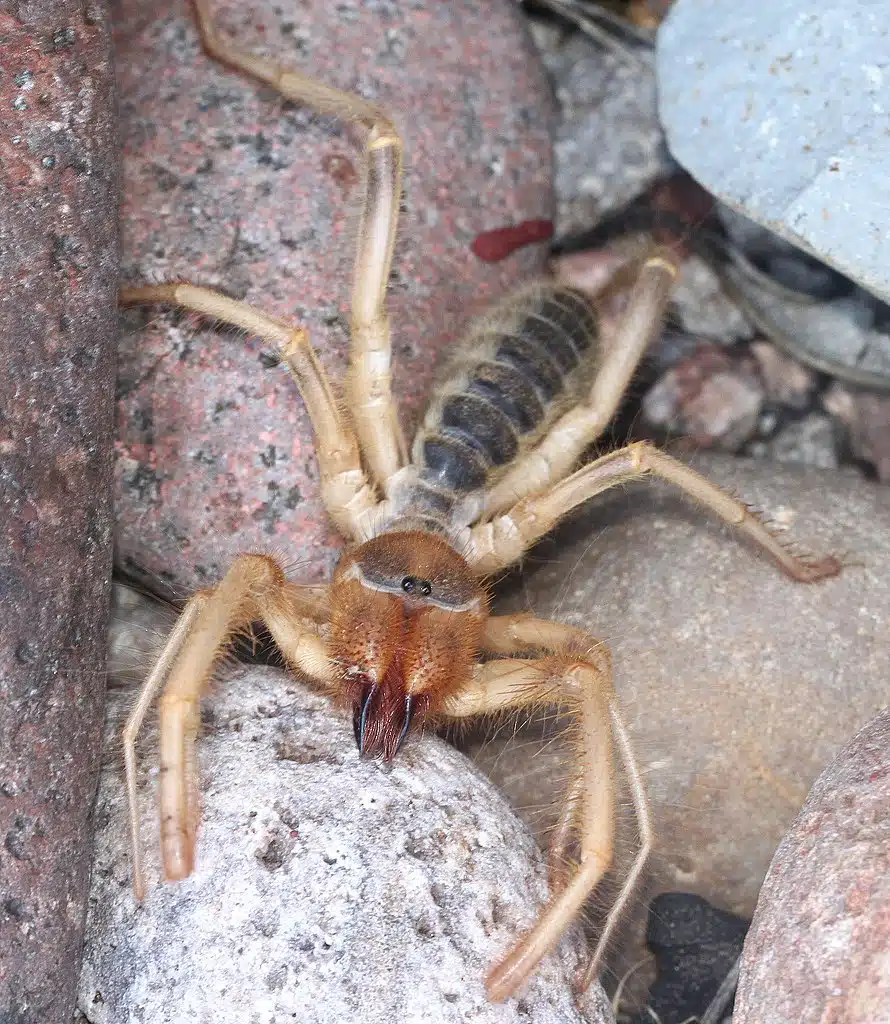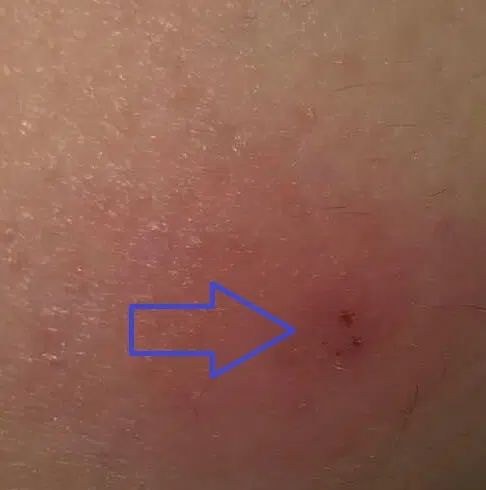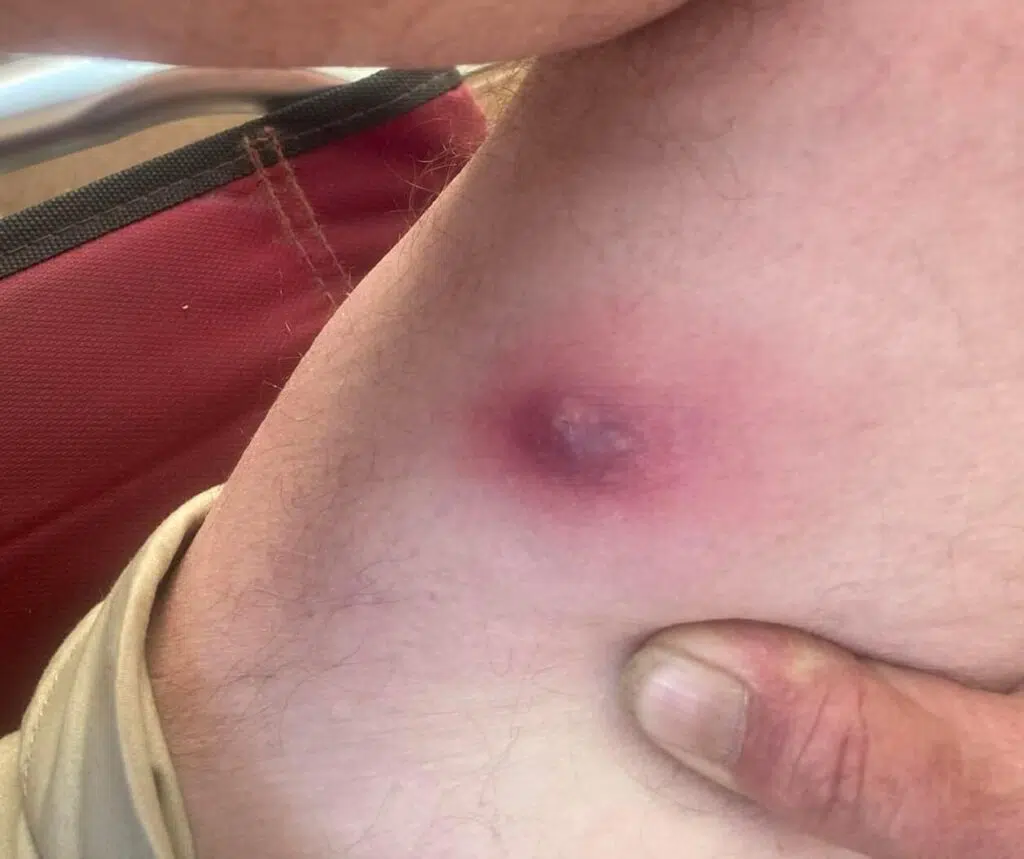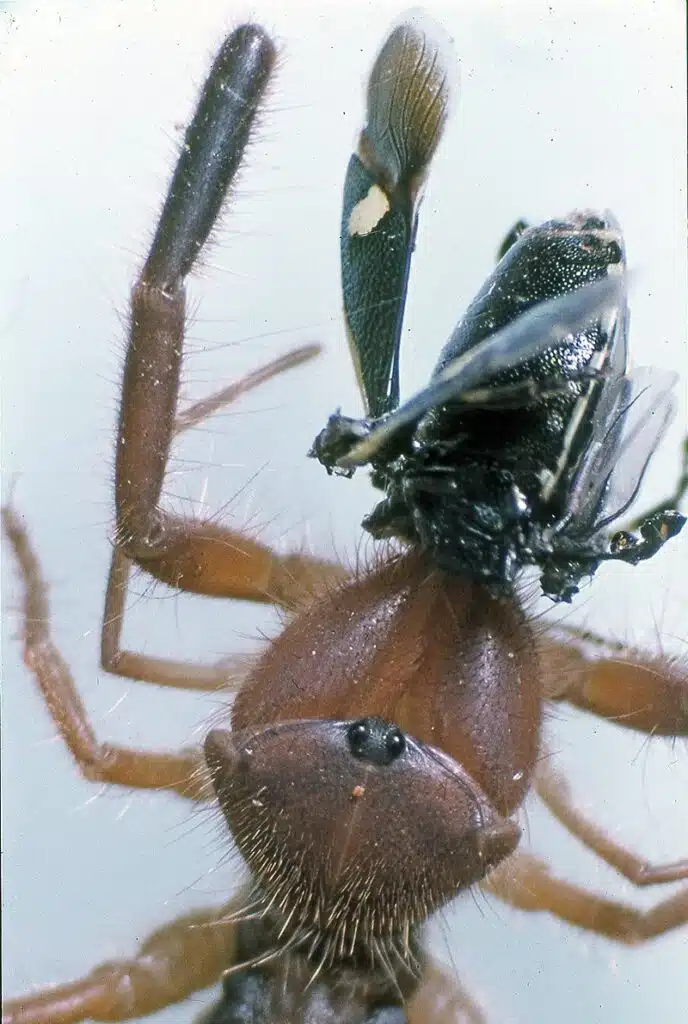Camel spiders are subjects of various legends. These spiders become increasingly popular with the advent of the 2003 Iraq war.
American soldiers used to record themselves with these giant spiders. Various myths such as a deadly bite on humans arose since then.
Camel spiders aren’t real spiders. They are solpugids of the solifugae family. Solpugids resemble spiders, but they are a different species.
Still, not all myths were unfounded. For example, Camel spiders remain vicious predators that can eat almost anything but they can also bite.
Since Camel spiders are very fast, they should be treated with caution to avoid a painful bite.
Table of Contents
Camel Spider Identification

Camel spiders are known to grow from a few millimeters up to a few inches. They can grow as large as 5-6 inches.
Camel spiders have 8 legs which make them resemble spiders. They have a hump shape similar to camels next to their head.
Camel spiders are nocturnal creatures that only look for food at night. Living in deserts, these solpugids hide in burrows, under vegetation, or rocks during the day.
Camel spiders are known to eat a lot. They are primarily fueling their high-energy lifestyle which often finds them reaching traveling speeds of up to 9 miles per hour.
Do Camel Spiders Bite?
Camel spiders don’t bite humans if not threatened and they aren’t venomous either.
However, you might get bitten whenever you handle a Camel spider, when you step on it, or when you poke it. Camel spiders might also bite you by mistake thinking you’re the type of prey they commonly go after.
It’s the jaws of the Camel spider that scare most people. Large and powerful, these jaws are known to bite through small prey easily.
The jaws of Camel spiders also pierce human skin. Their chelicerae easily penetrate the skin.
Camel spiders don’t bite unprovoked. The presumed fatal Camel spider bite is a myth. These spiders don’t follow humans either.
They only follow the shade of humans in deserts where Camel spiders live and try to escape the high heat during the day.
Camel spiders are also known not to come out during the day. They do not bite people during the day as nocturnal creatures.
However, Camel spiders bite other insects, scorpions, and ants. They do not refrain from using their large mouthparts to their advantage.
Camel Spider Bite Force
The jaws of camel spiders can be as large as a third of their body size. This makes Camel spiders known for their high bite force.
These powerful jaws are used to kill prey. Camel spiders use these jaws in saw-like movements to cut through prey.
However, they don’t necessarily eat whole parts of the prey as they prefer to insert enzymes into prey. These parts are liquefied and later consumed easier.
Are Camel Spiders Aggressive?
Camel spiders are known to be aggressive when handled or simply not left alone. They don’t chase people and they aren’t interested in a confrontation.
High aggression has been reported whenever they are handled. Camel spiders tend to run away when seeing humans
High aggression has also been reported whenever people dig for them in burrows or uncover them under rocks during the day.
Otherwise, Camel spiders hide all day as nocturnal species and avoid human contact at all costs.
Are Camel Spiders Venomous?
Camel spiders aren’t venomous. They only use their jaws as powerful weapons.
Jaws of Camel spiders are so large and powerful that many count them as legs mistakenly claiming they have 10 legs instead of 8.
While not venomous, Camel spiders use digestive enzymes to liquefy prey. They don’t eat prey as they prefer to drink it.
These enzymes are used to begin the digestion process outside of the Camel spider’s body.
Camel Spider Bite Symptoms
Camel spider bites are at least unpleasant. They are painful and they can be followed by certain infections.
The bite of the large Camel spider is certainly more painful than the bite of an ordinary non-venomous spider.

Camel spiders can pierce human skin while many regular spiders can’t. This means heavy bleeding is highly possible with each bite, unlike with the bite of a regular spider.
Camel spiders are most dangerous when biting and when their front part is facing you even if they can turn quickly.
Their mouthparts resemble crab mouthparts. Legs and pedipalps are held by the head, which further makes it resemble crabs.
Altogether, the front part of the Camel spider is called a prosoma.
The prosoma of the Camel spider can be located at the entrance of burrows or just on the edge of rocks in deserts which means you should stay away from these places as a quick attack might catch you by surprise.
Some of the most common symptoms or effects of a Camel spider bite include the following.
- Intense pain
The large jaws of the Camel spider are sometimes compared to pincers such as the pincers of crabs. The problem here is that these pincers can be used with sawing movements on the skin whenever the Camel spider bites.
All bites result in high pain. The pain is acute when the spider manages to pierce the skin.
Many people don’t see the Camel spider in the desert and get caught by surprise whenever the tan creature bites quickly.
- Red skin
Red skin is common both in the area of the bite and on the extended limb. If the Camel spider bites on one arm that arm can get red, as can bitten legs.
Red skin might also be the first sign of inflammation and possible infection. It’s best to keep an eye on the bitten area to avoid further inflammation.

- Itchiness
Itchy skin has been reported in the area of the bite. However, the symptom of itchiness has different levels, being more prevalent in the bites with infection compared to bites without any infection.
- Swollen skin
Almost all of those who experience an acute Camel spider bite see swollen skin. Piercing the skin comes with severe swelling.
This is treated by applying a wet cold bandage or ice. Swollen bites are also treated with medications against inflammation and possibly antibiotics.
- Intense bleeding
One of the areas that separate Camel spider bites from regular spider bites is bleeding. Heavy bleeding is common when a Camel spider bites.
Since regular spiders rarely get to fully pierce human skin many expect similar symptoms. However, Camel spiders are known to cause bleeding which may last up to a few minutes and which may require applying a bandage.
- Fewer
Mild or high fewer is one of the severe symptoms of Camel spider bites. Infections are known to cause fewer.
One of the few methods of keeping fewer away is by monitoring the bitten area for inflammation. However, fewer might be symptoms that aren’t always preceded by skin inflammation.
Camel Spider Bite Treatment
Camel spider bites might not be life-threatening compared to other venomous spider bites. They require some type of treatment, especially when it comes to preventing severe symptoms.
- Soap or salt with water
Cleaning the area is important soon after the bite. It’s best to only use clean cold water and soap to remove all bacteria in the area of the bite.
Soaking the area first might be important in the case of deep bites. Make sure to apply soap to clear the area of bacteria to prevent infections.
- Antibiotics
Antibiotics might be prescribed by doctors following a Camel spider bite. These might be oral antibiotics or antibiotic ointments.
Ointments are only applied to the clean bite area after washing it with soap and water. These are absorbed in the skin reducing inflammation and preventing infections.
Antibiotics should not be taken without the approval of a doctor.
A cool compress might be applied soon after rubbing the antibiotics ointment.
- Bandages
Bandages can be applied to the wound even without medical care after cleaning the bitten area properly.
Bandages are normally applied on wounds treated with certain creams to protect them from rubbing off against clothes.
You can use antibiotic creams, analgesic creams, and antihistamines on the bitten area before applying a bandage.
Where Are Camel Spiders Found?
Camel spiders or solifugids are known to live in many areas around the world, especially in deserts.
There are over 1.000 solifugids species across the world. They are seen on all populated continents but not in the deserts of Australia.
Camel spiders live in deserts where their tan coloring acts to their advantage as camouflage.
They are adapted to low humidity environments.
It’s here they can feed on various desert-specific prey such as lizards, rodents, snakes, and spiders among other species.
What do Camel Spiders Eat?
Camel spiders are carnivores. They have a diet exclusively based on vertebrates and invertebrates.

- Mice
Mice and rodents in general are preferred by Camel spiders. These are some of the most protein-rich foods as rodents are large compared to scorpions and other invertebrates Camel spiders might eat.
- Scorpions
Most scorpions live in deserts which means Camel spiders frequently eat them. Scorpions overpowered by Camel spiders were at the root of many myths surrounding solifugae species.
- Spiders
Small spiders are often consumed by Camel spiders. These aren’t among the favorites as they aren’t as meaty.
- Ants
Ants and even stinging ants are consumed by Camel spiders. A single Camel spider can eat up to a few hundred ants within a few days.
- Wasps
Camel spiders also eat wasps. Reports show Camel spiders eat invasive species such as wasps and termites.
- Beetles
Beetles are also consumed by Camel spiders, albeit in a reduced amount compared to rodents as they are more difficult to catch.
- Other solifugids
Camel spiders might also eat other solifugids. These can be solifugids of the same species or a different species.
How to Get Rid of Camel Spiders?
Getting rid of Camel spider that has gotten into your house or a car isn’t easy as they move very fast. Provided there’s no way to chase it out you can consider using sticky traps or vacuuming.
- Use sticky traps
Large sticky traps work best for large Camel spiders which can be a few inches large. Make sure to use the largest traps against Camel spiders whenever you find them inside the house.
- Consider vacuuming them
Only a powerful vacuum cleaner can vacuum Camel spiders. There are no other methods of getting rid of this species by hand without risking a bite.
How do I Keep Camel Spiders Away?
Keeping Camel spiders away is mandatory if you want to avoid bites. You can encounter them in your home or hotel (Western United States) or in deserts in many parts of the world.
- Keep a safe distance
Whenever you’re out in nature it’s best to stay away from Camel spiders. They can outrun you at a short distance so it’s best to stay as far as possible as soon as you see them.
Myths say Camel spiders chase people. This isn’t true. They might only rest in the shade of people or in the shade of a campsite in the desert to protect themselves from the harsh sun.
- Don’t pick up rocks in deserts
Rocks are known to be the hiding place of Camel spiders, snakes, scorpions, and other spiders out in the desert. With limited to no vegetation there’s nowhere for them to hide.
You should not turn over rocks or sit on them in desert areas as they might be hiding Camel spiders.
- Don’t touch Camel spiders when found indoors
You should refrain from touching Camel spiders if you see them outside or indoors. Even poking them with a stick isn’t recommended as they are known to be aggressive.
Camel spiders should be left alone and people should slowly move away without interaction. They are known to only become aggressive when threatened or when handled.
- Check doors and windows close properly
Camel spiders don’t easily get indoors since they’re larger than the average spider. Growing to a size of a few inches makes Camel spiders unlikely to crawl through small cracks in walls or around doors.
However, they might crawl under doors in case of large openings. They can only move indoors quickly if they find an open door, especially at night when looking for food.
Summary
Camel spider’s bites are frequent when they are handled. These aren’t lethal bites but they are painful and accompanied by heavy bleeding since the large crab-like mouthparts easily pierce the skin.
Camel spider bite symptoms include severe pain, swollen skin, and even fewer others. These symptoms are treated with antibiotics in the case of infections or inflammation. Mild Camel spider bite symptoms might disappear after cleaning the area with soap and water and applying a clean cold compress to the wound.